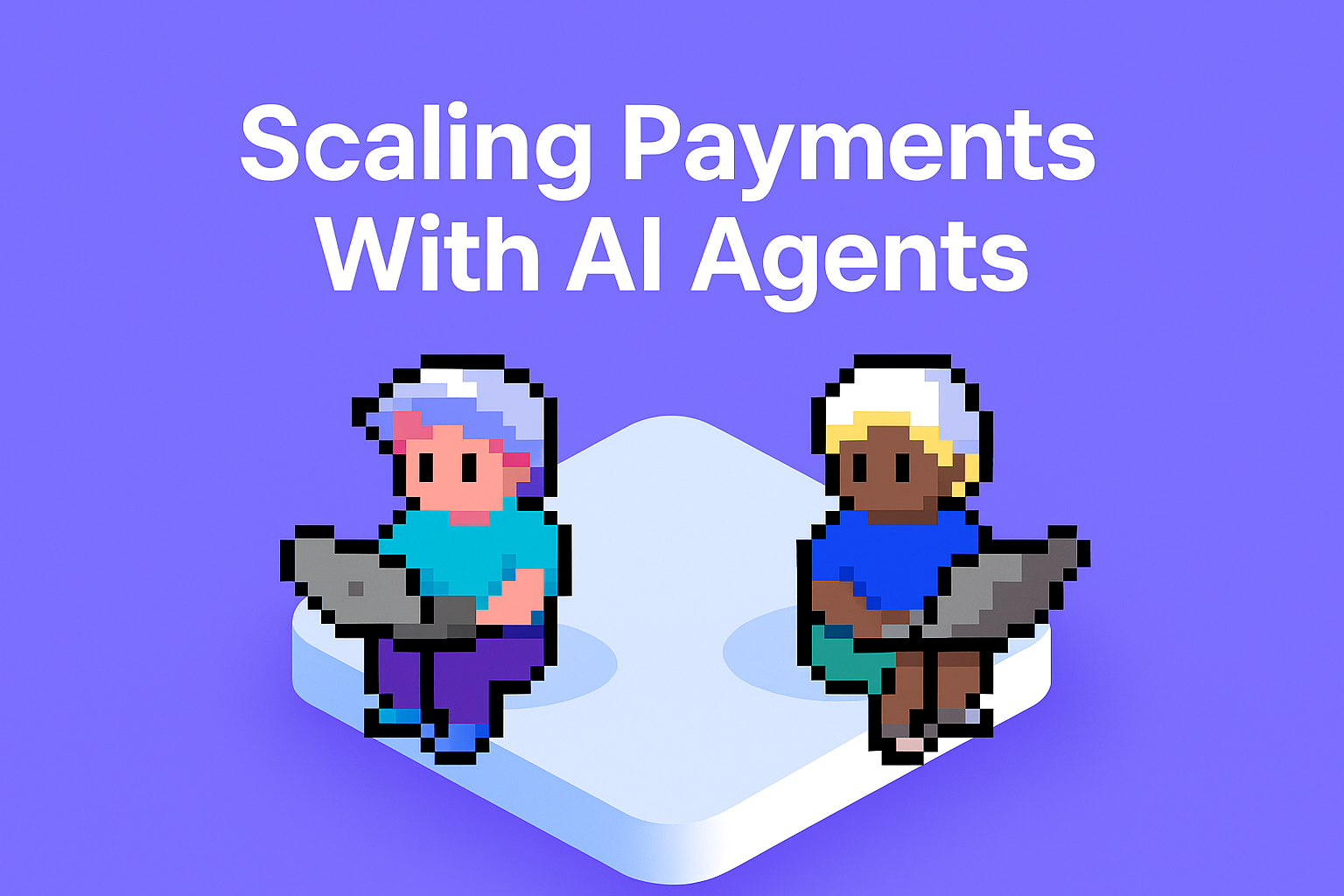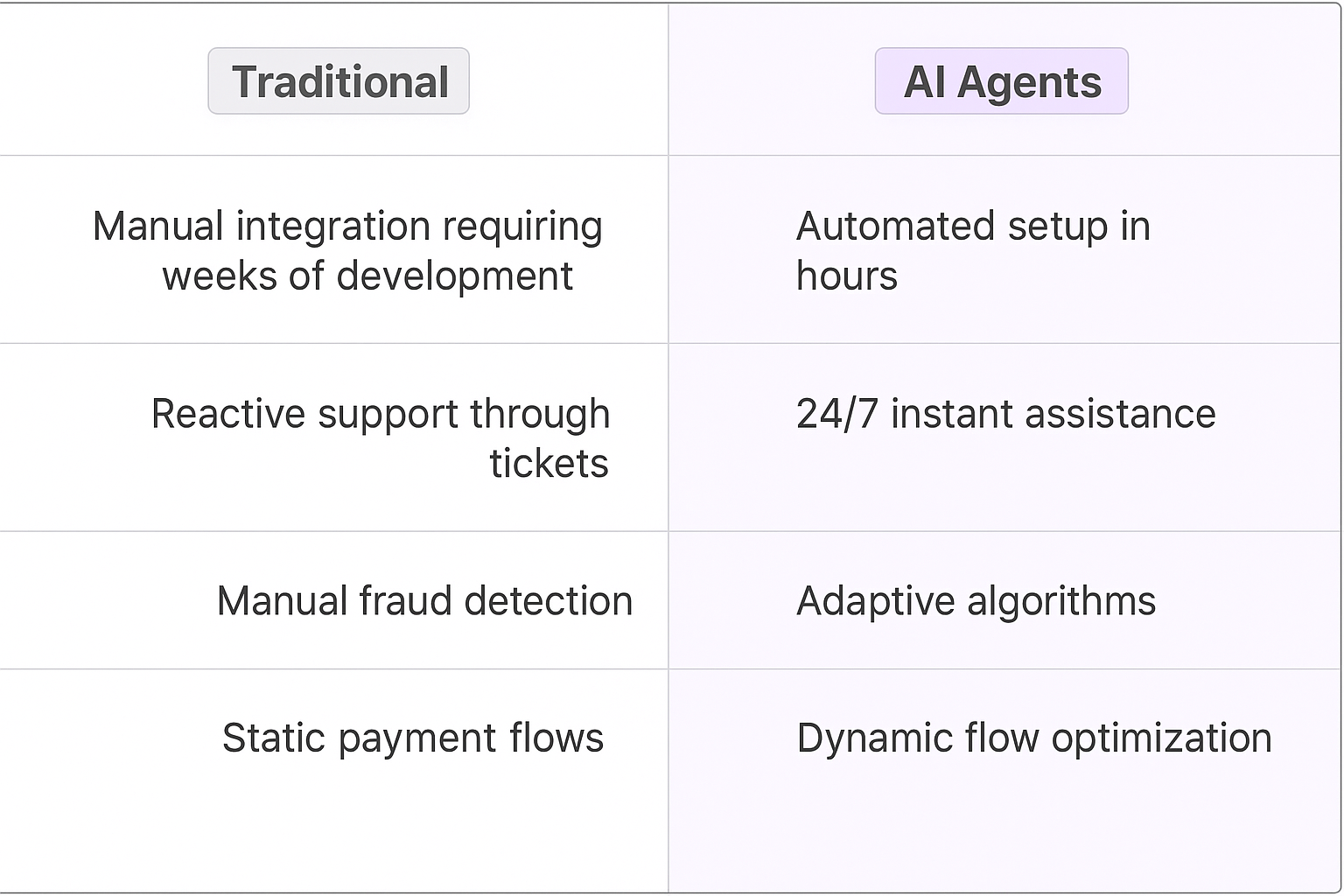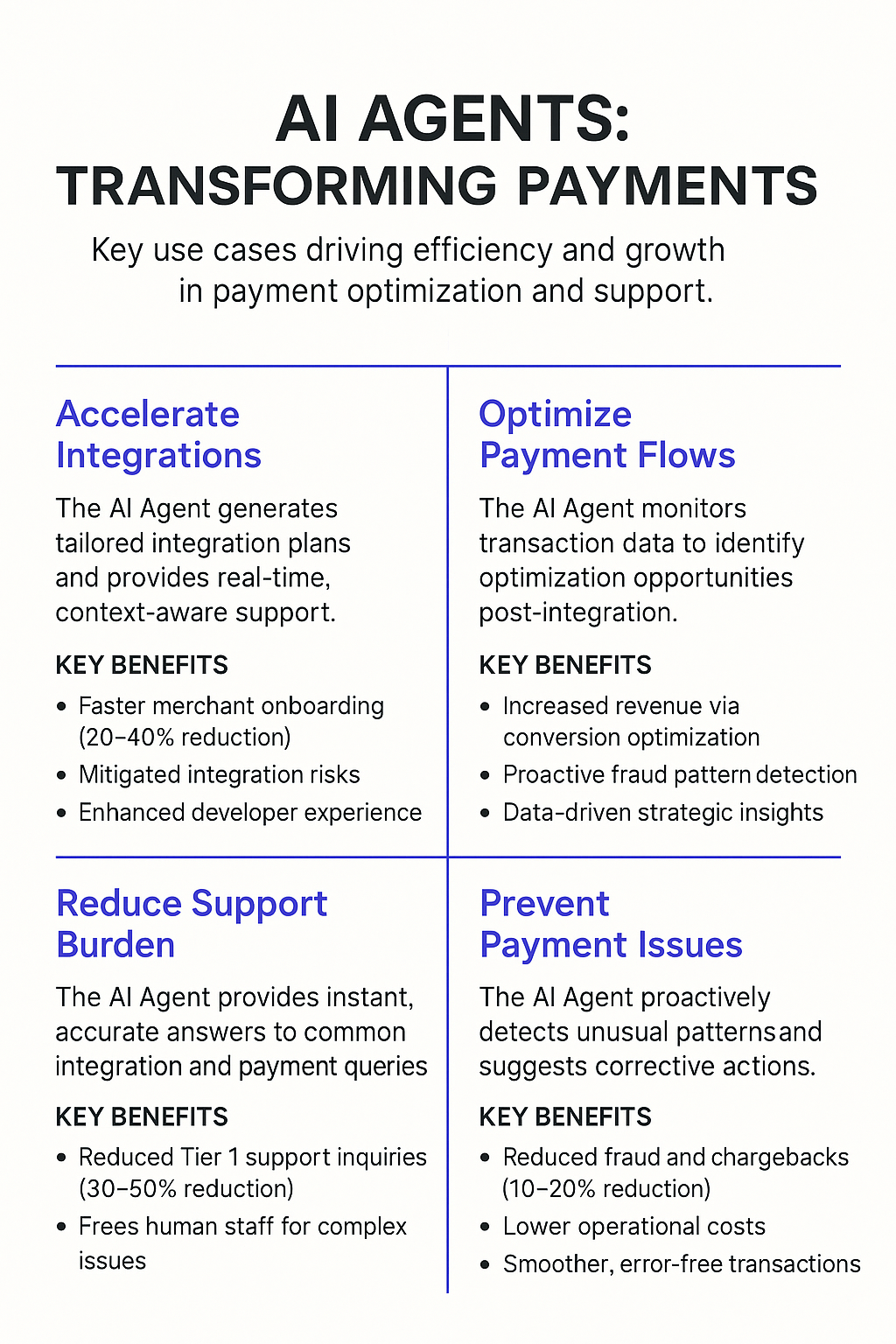Stripe AI Agents
The Foundation of Online Payment Processing
Stripe is a technology company that builds economic infrastructure for the internet. It provides a suite of payment processing tools that allow businesses of all sizes to accept payments online and in mobile apps. Stripe's platform is designed to be developer-friendly, with robust APIs and extensive documentation that make it easier for companies to integrate complex payment systems into their products and services.
Key Features of Stripe
Stripe's core offering includes payment processing for credit cards, debit cards, and digital wallets. But it goes far beyond that. Stripe offers a comprehensive toolkit for managing subscriptions, invoicing, fraud prevention, and financial reporting. Its global reach allows businesses to accept payments in multiple currencies and expand into international markets with ease. Stripe also provides tools for marketplace platforms, enabling complex multi-party transactions and payouts. With its focus on developer experience, Stripe has become the go-to payment solution for startups and established enterprises alike, powering the financial operations of millions of businesses worldwide.

Benefits of AI Agents for Stripe
What would have been used before AI Agents?
Before AI agents entered the scene, Stripe users were navigating a complex landscape of documentation, support tickets, and manual processes. They'd spend hours poring over API references, wrestling with integration challenges, and waiting for human support to tackle their issues. It was like trying to build a skyscraper with a Swiss Army knife – possible, but painfully inefficient.
Developers were the unsung heroes, burning the midnight oil to decipher error codes and optimize payment flows. Customer support teams were swamped, juggling an endless stream of queries ranging from basic setup questions to intricate compliance issues. It was a world where time-to-market was measured in weeks or months, not days or hours.
What are the benefits of AI Agents?
Enter AI agents for Stripe – they're not just tools; they're digital teammates that fundamentally reshape how businesses interact with payment infrastructure. These agents are like having a Stripe expert on speed dial, but one that never sleeps and can handle thousands of conversations simultaneously.
First off, they're slashing integration times. Developers can now have real-time, context-aware conversations about API endpoints, webhooks, and SDKs. It's like pair programming with an omniscient partner who knows every nook and cranny of Stripe's ecosystem.
For business teams, these AI agents are demystifying the complex world of payments. They're translating technical jargon into plain English, helping non-technical staff understand and leverage Stripe's capabilities. This democratization of payment knowledge is a game-changer for cross-functional collaboration.
But here's where it gets really interesting: these AI agents are pattern recognition machines. They're identifying common integration pitfalls before they happen, suggesting optimizations that humans might overlook, and even predicting potential compliance issues based on a company's unique setup. It's proactive problem-solving at scale.
The ripple effects are profound. With AI agents handling the bulk of routine queries and troubleshooting, Stripe's human experts are freed up to focus on high-value, strategic initiatives. This shift is accelerating Stripe's product development cycle, potentially leading to more innovative features and integrations down the line.
Moreover, these AI agents are learning and evolving with every interaction. They're becoming smarter about industry-specific needs, from subscription billing nuances for SaaS companies to complex marketplace payment flows. This continuous improvement cycle means that the value proposition for Stripe users is constantly expanding.
In essence, AI agents for Stripe aren't just enhancing a product – they're redefining the entire payment infrastructure experience. They're compressing years of payments expertise into milliseconds of response time, turning Stripe from a tool into a true digital teammate. This isn't just an iteration; it's a step change in how businesses think about and interact with their payment stack.
Potential Use Cases of AI Agents with Stripe
Processes
Stripe's payment infrastructure is a beast, and AI agents are the perfect tamers. These digital teammates can dive deep into Stripe's complex ecosystem, handling intricate processes that would make even seasoned developers sweat. Think about reconciliation - that mind-numbing task of matching transactions across multiple systems. An AI agent could plow through this, cross-referencing data from Stripe's API with your internal records, flagging discrepancies, and even suggesting resolutions.
But that's just scratching the surface. These AI agents could become your Stripe optimization gurus. They'd analyze your payment flows, identify bottlenecks, and propose tweaks to reduce friction and boost conversion rates. It's like having a payments expert on call 24/7, constantly fine-tuning your setup for peak performance.
Tasks
When it comes to day-to-day tasks, AI agents can be game-changers for Stripe users. Consider dispute management - a notorious time-sink for many businesses. An AI agent could automatically gather relevant transaction data, craft compelling responses, and even predict the likelihood of winning based on historical patterns. It's like having a seasoned chargeback specialist in your pocket.
Another killer application? Real-time fraud detection. AI agents could analyze transaction patterns, customer behavior, and external data sources to flag suspicious activity before it hits your bottom line. They could even adapt their algorithms on the fly, staying one step ahead of evolving fraud tactics.
Let's not forget about customer support. AI agents could field common Stripe-related queries, guide users through payment issues, and even proactively reach out when they detect potential problems. It's like giving every customer their own personal Stripe expert.
The beauty of these AI agents is their ability to learn and improve over time. They're not static tools, but evolving digital teammates that get smarter with every interaction. As they accumulate knowledge about your specific Stripe setup and business needs, they'll become increasingly valuable assets in your payment operations arsenal.
In the world of payments, where milliseconds and basis points can make or break a business, these AI agents aren't just nice-to-haves. They're becoming essential for staying competitive in an increasingly complex and fast-paced landscape. The companies that figure out how to leverage these digital teammates effectively will have a serious edge in the payments game.

Industry Use Cases
The versatility of AI agents in Stripe makes them valuable across various industries. Let's dive into some meaty, industry-specific use cases that showcase how AI can transform workflows and processes in ways that'll make you rethink your entire approach to payments and financial operations.
These aren't your run-of-the-mill efficiency boosters. We're talking about AI that's so deeply integrated into Stripe's ecosystem, it's like having a team of financial wizards working 24/7 to optimize every aspect of your business. From fraud detection that's smarter than the craftiest cybercriminals to personalized pricing strategies that make your revenue graphs look like hockey sticks, these use cases are the real deal.
So buckle up. We're about to explore how Stripe's AI agents are reshaping industries, one transaction at a time. And trust me, by the end of this, you'll be itching to implement these digital teammates in your own financial operations.
E-commerce: Stripe AI Agents as Revenue Catalysts
Let's talk about e-commerce. It's a jungle out there, and every merchant is fighting for their slice of the pie. Enter Stripe AI Agents - the secret weapon that could turn the tide in this digital gold rush.
These AI-powered digital teammates aren't just processing payments; they're becoming the unsung heroes of conversion optimization. Imagine an AI that learns from every transaction, every abandoned cart, every successful upsell. It's like having a seasoned sales team that never sleeps, never takes a coffee break, and operates at the speed of light.
Here's where it gets interesting: These agents can dynamically adjust pricing strategies in real-time. They're not just reacting to market trends; they're predicting them. They're analyzing user behavior patterns faster than any human could, identifying the perfect moment to offer a discount, suggest a complementary product, or nudge a hesitant buyer.
But it's not all about pushing for the sale. These AI agents are also becoming masters of customer retention. They're tracking post-purchase behavior, predicting churn before it happens, and crafting personalized re-engagement strategies. It's like having a crystal ball that not only sees the future but actively shapes it.
The real kicker? As these AI agents learn and evolve, they're not just optimizing individual stores. They're creating a network effect across the entire Stripe ecosystem. Insights gained from one merchant can benefit another, creating a rising tide that lifts all boats.
This isn't just about automating tasks; it's about unlocking new levels of e-commerce intelligence. We're talking about AI that doesn't just process transactions, but understands the intricate dance of consumer psychology, market dynamics, and data-driven decision making.
In the cutthroat world of e-commerce, Stripe AI Agents aren't just tools; they're becoming the differentiator between the merchants who survive and those who thrive. Welcome to the new frontier of digital commerce, where AI isn't just assisting - it's leading the charge.
SaaS: Stripe AI Agents as Growth Hackers on Steroids
Let's dive into the SaaS world, where customer acquisition costs can make or break a startup. Stripe AI Agents are about to flip the script on how we think about growth hacking.
These digital teammates are the ultimate A/B testers, but on a whole new level. They're not just tweaking landing pages; they're orchestrating entire customer journeys. Think of them as growth hackers that never sleep, constantly iterating on pricing models, feature gating, and onboarding flows.
What's really mind-blowing is how these AI agents are becoming masters of the 'aha moment'. They're analyzing user behavior patterns across thousands of SaaS companies, identifying the exact features and interactions that lead to long-term retention. It's like having a psychic that can predict which users will become power users before they even know it themselves.
But here's where it gets really interesting: These AI agents are starting to crack the code on virality. They're not just optimizing referral programs; they're creating entirely new viral loops based on user behavior and network effects. We're talking about AI that understands the social dynamics of product adoption better than any growth team ever could.
The real game-changer? These AI agents are becoming experts in reducing churn. They're not just sending out win-back emails; they're predicting churn before it happens and orchestrating personalized re-engagement campaigns that feel more human than most human interactions.
As these AI agents evolve, they're creating a network effect across the entire SaaS ecosystem. Insights gained from one company's success can be applied to others, creating a rising tide of growth hacks that lifts all boats.
This isn't just about automating growth tactics; it's about unlocking new levels of growth intelligence. We're entering an era where AI doesn't just assist growth teams - it becomes the growth team. And in the hyper-competitive world of SaaS, that could be the difference between unicorn status and the startup graveyard.

Considerations and Challenges in Implementing Stripe AI Agents
Integrating Stripe AI agents into your payment ecosystem isn't just a plug-and-play solution. It's a complex dance of technology, user experience, and business strategy. Let's dive into the nitty-gritty of what you're really signing up for.
Technical Challenges
First off, you're looking at a significant API integration effort. Stripe's API is robust, but it's also intricate. You'll need developers who can navigate its complexities and ensure seamless communication between your systems and Stripe's AI agents. This isn't just about making a few API calls; it's about architecting a system that can handle real-time transactions, webhooks, and data synchronization.
Data security is another beast altogether. You're dealing with sensitive financial information, so your implementation needs to be bulletproof. This means end-to-end encryption, secure data storage, and compliance with standards like PCI DSS. One slip-up here, and you're not just facing technical issues, but potentially legal ones too.
Operational Challenges
On the operational front, you're looking at a shift in how your team handles payment processing. AI agents will take over many tasks, but they're not infallible. You'll need to train your staff to work alongside these digital teammates, understanding when to let the AI handle things and when human intervention is necessary. This isn't just a tech upgrade; it's a cultural shift in how your organization approaches payments.
Customer support is another area that'll need a rethink. When issues arise (and they will), your support team needs to be equipped to troubleshoot problems that involve AI decision-making. This requires a new skill set and possibly a restructuring of your support workflows.
Strategic Considerations
From a business strategy perspective, implementing Stripe AI agents is a double-edged sword. On one hand, you're looking at increased efficiency and potentially lower operational costs. On the other, you're tying yourself more closely to Stripe's ecosystem. This could impact your flexibility in negotiating rates or switching providers down the line.
There's also the question of how this impacts your product roadmap. Integrating AI agents into your payment flow could open up new possibilities for features and services. But it also means aligning your product development more closely with Stripe's capabilities and limitations.
The Human Element
Don't underestimate the human factor in all of this. Your customers are used to certain payment experiences, and introducing AI agents will change that. You'll need to carefully manage this transition, ensuring that the new process feels intuitive and trustworthy. Remember, payments are a high-stakes game for users; any perceived loss of control or understanding could lead to abandoned carts and lost revenue.
Implementing Stripe AI agents isn't just a tech decision; it's a business transformation. It requires a holistic approach that considers technical, operational, and strategic implications. Get it right, and you could be looking at a significant competitive advantage. Get it wrong, and you might find yourself tangled in a web of technical debt and operational headaches.
The Future of Intelligent Payment Processing
The integration of AI agents with Stripe marks a pivotal moment in the evolution of payment processing. These digital teammates are not just enhancing existing processes; they're fundamentally reshaping how businesses interact with financial infrastructure. By slashing integration times, demystifying complex payment flows, and providing real-time, context-aware support, AI agents are democratizing access to sophisticated payment technologies.
The ripple effects of this transformation extend far beyond mere efficiency gains. We're seeing a shift towards more proactive, intelligent payment systems that can predict issues, optimize flows, and even drive business growth. From e-commerce to SaaS, industries are being reshaped by the capabilities these AI agents bring to the table.
However, this transformation doesn't come without challenges. Businesses must navigate complex technical integrations, rethink operational processes, and carefully manage the human element of this transition. The strategic implications of deeper integration with Stripe's ecosystem also require careful consideration.
Despite these challenges, the potential benefits are too significant to ignore. As these AI agents continue to learn and evolve, they're creating a network effect that benefits the entire Stripe ecosystem. We're entering an era where payment processing is not just a necessary business function, but a potential source of competitive advantage.
The future of payments is intelligent, proactive, and deeply integrated into the fabric of business operations. Those who successfully harness the power of Stripe's AI agents will find themselves at the forefront of this revolution, well-positioned to thrive in an increasingly digital and automated business landscape.










